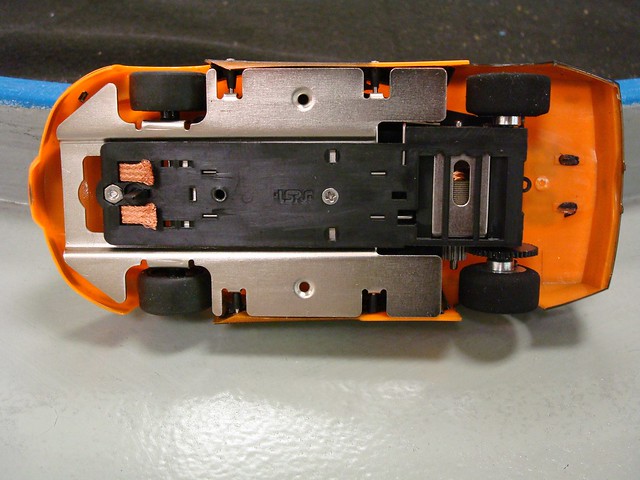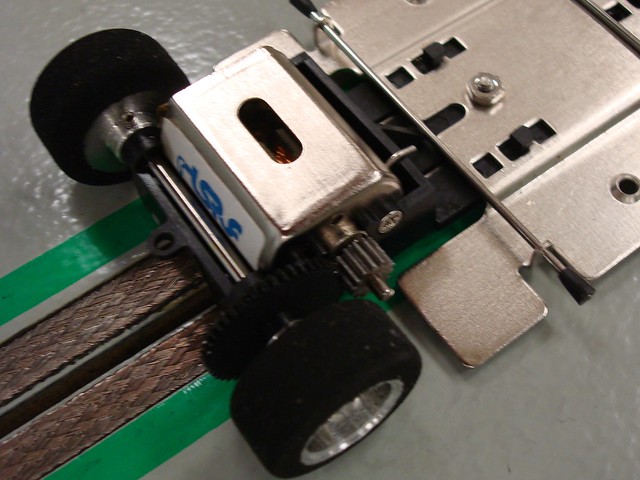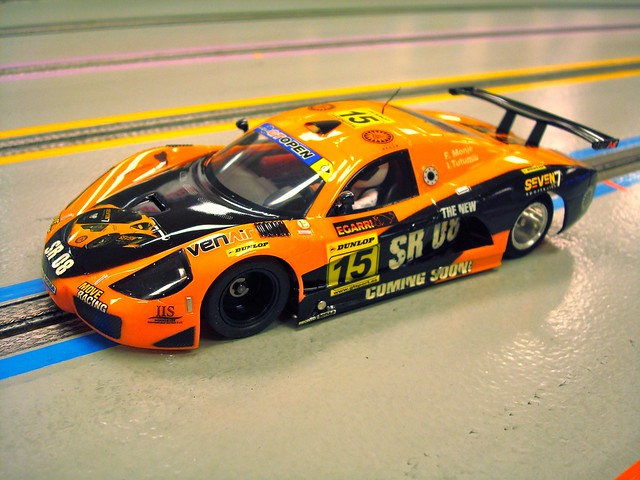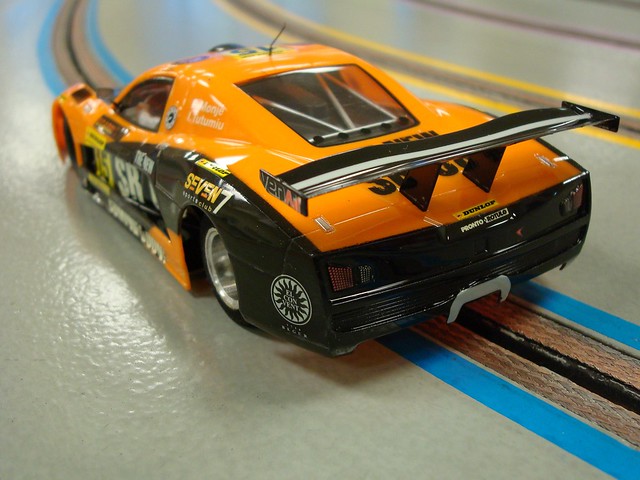By M.G. Brown

Most 1/32 and 1/24 racers in North America are familiar with the “True Scale Racing” line of chassis, motors and parts distributed by Topline, Inc of California. The “TSRF” cars have been on the market for a good 2 years now but until now there has not been a true “ready to race” 1/32 TSRF car that was suited for sectional tracks such as you would find in the average slot racing enthusiast’s basement or garage.
That has all changed now with the introduction of the first Pro Series RTRs in TSRFs line.
The initial RTR body style is the Sunred SR21 GT; it is available in 3 decorations representative of the cars as they were raced in the “GT Open” series during 2008. Topline informs me that around the end of January, a Riley Daytona prototype body style will be added to the TSR Pro Series line in a number of decorations.
TSRF spokesperson and Slot racing legend Philipe de Lespinay has published a comparison of the TSRF Pro Series RTR performance versus other popular 1/32 RTR cars. The test was done on Carrera sectional track, and the Pro Series car packaging states that it is optimized (as purchased) for Carrera track. With small modifications, the TSRF Pro Series RTR can be adjusted to run well on any sectional track system, and also on routed (wood) track.
Since PdL has done a fine job testing the car on sectional track about the size and layout that the average racer might have in their home, and since I have the track that the 2010 ISRA World Championships was contested on at my disposal, I felt it would be interesting to test the TSRF Pro Series RTR on Mid-America Raceway and Hobbies Gary Gerding built 148 foot “Monster” flat track.
Please note that this is not the type of track or environment that the car was designed, or is optimized for.
In the greater Chicago area, we have just started racing 1/32 RTR cars weekly at Mid-America Raceway. After a few weeks of sorting through the RTR offerings of several companies, the Slot.it Group C “RAW” cars seem to be the overwhelming favorite. I feel that the Slot.it RTRs are clearly the benchmark that the new TSRF Pro Series must be measured against.

TSR chassis design overview
Both the 1/32 and 1/24 TSR cars are similar in design- A two piece chassis with a metal “body mounting pan” and a glass-filled plastic center section that neatly ties together all of the electrical and mechanical components. Three possible choices of chassis locations and three front axle locating holes make the mounting of most any 1/32 injection molded or clear plastic body a snap.

When first introduced on the market the purchaser had the choice of a standard model with glass-filled plastic wheels and spur gear, or a “Club Sport” model that had alloy wheels and gear. TSRF offers 3 tire compounds; a standard “gevon” compound, a custom Ortmann compound and a sponge rubber tire. The gevon and Ortmann tires are intended to be used on the plastic wheels or the Club Sport alloy wheels, while the sponge compound is intended to be used on the alloy setscrew wheels.

The motor in all TSRF cars is a “FK-130” series sealed can imported from China with a milder wind than the TSRF FK D3 racing motors.
The SCNews motor list rates the TSR “Nickel” motor as used in the Pro Series RTR at a stout 36,700 RPM at 12V DC. Please note that the design of the TSR Pro Series chassis allows the easy installation of any popular FK series motor including the 47,600 RPM TSRF “D3” motor. Removal of two screws and the motor swaps out quite simply- the “bus bar” wiring system does not even require soldering to change motors.
The TSR Pro Series RTR comes standard with silky smooth 64 pitch gears; the standard spur is glass-filled plastic with 45 teeth. The standard pinion is stainless steel with 14 teeth giving a 3.21:1 ratio. Optional alloy setscrew gear sets are available including 14-45, 13-46, 12-47, and 11-48.
An ongoing source of controversy is the “pin” guide and fixed pickup brush system that is used on the TSR cars. I have had a background in HO Scale racing with the Tri-State HOPRA going back some years. I am not sure why there has been such uncertainty about the TSR system, which is clearly based on the design used successfully in race-winning HO “pro” cars for at least 30 years.
The TSR pickup brushes are captured in place by a clever screw-mount bracket, which I feel makes pickup brush changing and adjustment much easier than the eyelet - wire system universally used by other high performance RTR companies.
The TSR Pro Series RTR comes with an indestructible stainless steel guide pin, and optional nylon guide pins are available in “standard” (suitable for sectional track) and “deep” (suitable for routed track) styles. I prefer the nylon deep guide for use on commercial tracks and that is how our test car was equipped.
My favorite feature of the TSR chassis is the clever front axle and wheel/tire setup. The wheel assemblies rotate independently on a solid axle that is attached to the steel body mount plate. Small “E” clips securely hold the wheels in place on the axle from the outside. Once in place, the front end has a very precise alignment and the wheels spin freely.
All chassis components- down to the motor retaining screws and chassis movement adjusting bolt are available from TSRF as spare parts. The 64 pitch gear sets have become popular for replacement use on Fly Classic sidewinders but I am assured that there is ample stock for spares.
I feel the TSR chassis is a joy to work with and it can be totally disassembled and re-assembled using only a Phillips screwdriver in a matter of minutes. In a lot of ways the TSR chassis reminds me of a well-made musical instrument in the way things fit together with close tolerances.
TSR RTR Body Overview
The sharp-eyed among our readers have probably already guessed that the TSR Pro Series RTR is using the Flyslot “Madness” body.


There are varying opinions of the aesthetic appeal of the Sunred SR21’s lines, but for racing purposes it is an excellent choice. The body weighs in at an astonishing 22 grams complete with all exterior detail, “tray” interior and half-figure driver. Considerable un-needed weight could be trimmed from the underside of the body and interior tray at no sacrifice in realism if you so desire.
The windows are molded into the body much the same as Tamiya’s RC “hardbodies” so what weight is on the body is largely below the centerline. I'd love to know how they do this- it's fascinating to examine.
The mounting is the tried and true tube and pin system universally used by 1/24 “pro” racers around the world. It is quick and easy to remove the body without tools and without the fear of stripping or breaking the plastic screw posts as found on other 1/32 RTRs.
Track Test
Since the Mid-America Raceway and Hobbies “Monster” track is used mostly for 1/24 scale racing, it has a thin film of spray traction dressing on its surface- making sponge tires mandatory for best speeds.
For these tests the Pro Series standard Ortmann tires were initially replaced with TSRF sponge tires on alloy setscrew wheels. The tires were first trued and brought to the exact diameter of the Ortmann tires to eliminate any performance differences due to clearance etc.
I felt that the TSRF sponge tires were just a bit soft for the track conditions and after some experimenting, found the best lap times could be achieved with the “spec” tire that we use in our 1/32 RTR weekly racing; the Scale Auto “Red Stripe large hub”. The Scale Auto tires are a slightly harder compound and were trued to the same diameter as mentioned above.
Experimentation also found that the TSR Pro Series handled more consistently with weight placed in ahead of the guide on the metal body mount. Interestingly there is a recessed area on the body mount which seemed to be custom made for weight placement.
Once the tire and weight issues were sorted out- we got down to finding out exactly what this new offering could do.
The fastest Slot.it “RAW” cars in our 1/32 racing series are hovering right around a 9.1 second lap (16.26 FPS) after weeks of tuning and adjusting.
With a tire change and weight tuning, the otherwise stock TSR Pro Series was turning comfortable 9.8 second laps (15.10 FPS).
I felt that the stock gear ratio was holding the car back from faster lap times on our relatively large track, but as is, the TSR Pro Series felt very smooth and consistent. A tester noted that the car was quiet and easy to drive consistently lap after lap.
I am sure that additional tuning might gain at least two tenths of a second with gear changes bringing another two tenths- putting the basically stock car in the same grouping with our fastest Slot.it “RAW” cars.
We probably ran over 200 laps in testing with the TSR Pro Series car and the only issue was that the left side mirror was knocked off of the body during a particularly hard contact with the wall. The mirrors are apparently designed to pop out of the body on hard contact and it popped back in to its holder easily (once the errant part was located!) with a satisfying click.
I noticed after the testing that one of the rear wing support struts had been slightly bent from crash damage; but this is a well-documented problem with the Flyslot “Madness” cars- and easily fixed with some 3-M filament reinforcing tape.
Overall I feel the TSR Pro Series RTR offers a lot of value for both the home racer and the commercial track competitor. We plan a 24 Hour enduro in the near future at Mid-America, and I feel that this will be the true test of the TSR-RTR.
I will be sure to publish an update after the enduro for the Slot Car News readers.

T3210(x)S TSRF Pro Series RTR available in Orange (3), Red (4) and White (5) decoration.
$109.95 + Postage
Available from tsrfcars.com, electricdreams.com and other TSRF retailers.
No comments:
Post a Comment